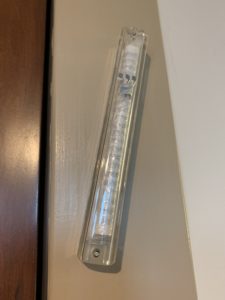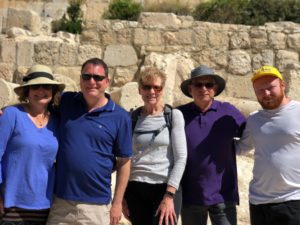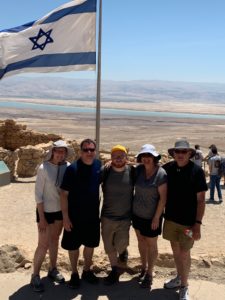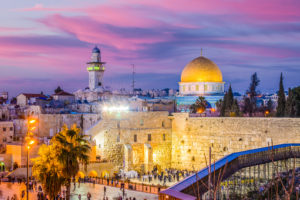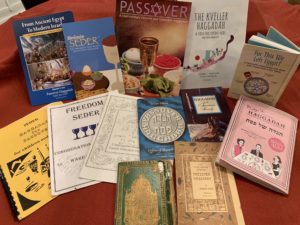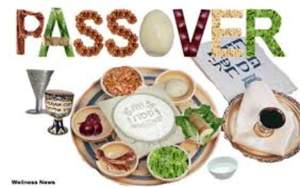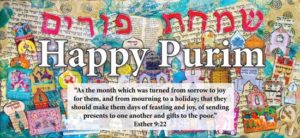Rosh Hashanah Mezuzzah Symbolizes New Beginnings
When I think of the High Holidays, many traditional symbols come to mind—
the sound of the shofar, an instrument made of a ram’s horn that signals the awakening of the Jewish people. The short and long blasts of the shofar—tekia, sh’varim, teruah, and tekia gedolah—summon us to come together and renew our relationship with each other, ourselves, and, of course Hashem. Crisp apples dipped in honey tempt our taste buds for a sweet new year, while we try a new fruit to symbolize gratefulness for being alive and allowing us to enjoy all the delicious fruit of the creator. A favorite fruit on this holiday is the pomegranate for its biblical significance—the Land of Israel is known for its pomegranates and is one of the “seven species†for its abundant seeds (613 to be exact) associated with fertility and good deeds, specifically the 613 mitzvot in the Torah. Here’s a good way to seed a pomegrante!
Challah is eaten all year round on Shabbat, but on the High Holidays the braided loaf is made into a round shape that represents the crown of a king for it was on Rosh Hashanah, the birthday of mankind, the sixth day of creation, that Hashem was coronated as King of the Jewish people. Another symbolic ritual during the 10 Days of Awe is tashlich, meaning “casting off†our sins of the previous year by tossing pieces of bread or another food into a natural body of flowing water. Beautiful melodic prayers such as the Armaic words of Kol Nidre, meaning “all vows,” and Avenu Malkenu, “Our Father Our King,” stir our emotions as we dig deep into our soul, asking and granting forgiveness of others and ourselves to release burdens we carry and start anew.
This year, for the first time, another Jewish symbol was added to the High Holidays for my family. The mezuzzah that we hung in my son’s new apartment on the Sunday before Rosh Hashanah. Continue reading
Shavuot: The Greatest Gift that Keeps on Giving
Where to start about describing my recent two-week pilgrimage to Israel
to visit my 24-year-old son Jack who has lived in Jerusalem for the last nine months to teach English to Israeli elementary school children???  First, a little kvelling…While Jack creates project-based curriculum to teach these kids basic English words and concepts, these fourth-sixth graders help him brush up on his Hebrew, so its a win-win. In his spare time, Jack has spearheaded study groups led by rabbis, empowered at-risk teens and young adults to breakdance, and coached a youth baseball team on the side, to name a few extra curricular activities, all while networking with Jewish peers, educators, and leaders from all over the world. The last time I visited Israel was with a group of Jewish moms six years ago, and this time around was even more fulfilling because I not only had a greater appreciation for my homeland, but also because I was with my husband and in-laws who had never been to Israel. To witness them experience a deeper understanding and love of Israel, whether it was when we explored Masada, or toured the innovation museum,  or walked through the underground bullet factory, was well worth the 12-hour plane ride to get there and the jet lag that lasted for days. I’ve been photo blogging about our journey to Tel Aviv, Tzvat, and Jerusalem, on my Facebook page HERE.  So, while I continue to process how incredible my time was in “The City of Gold” with Jack, who has made the holy land his second home, I guess you could say I had my own personal revelation,  just in time for the upcoming holiday of Shavuot, which marks the 3,331-year anniversary of the Jewish people receiving the Torah at Mount Sinai. Turns out my family was in the land of milk and honey during the month of Omer leading up to the single most important moment in of all of human history–when God entrusted the Ten Commandments to Moses and the Israelites. This was the time when the Jews were given a responsibility to not only accept the teachings of the Torah but to pass these valuable life lessons from generation to generation. On this trip to Israel, I took in an intense amount of learning about myself and Judaism and I know that wherever I go in this world, I will take this feeling of Yerushalayim with me. The Midrash tells us that before Hashem gave us the Torah, we had to pledge that “Our children will be our guarantors!”  And many time, it’s our children who are teaching us, and I definitely feel that Jack inspires me in many ways to be a better person.
Pack The Traveler’s PrayerOn Your Next Trip
In Judaism, there is a prayer for everything, whether it’s finding lost luggage or helping someone find their perfect match, both of which I’ve done recently.
When we open our eyes in the morning, we thank God for the gift of a new day. Modeh ani. When we go to bed at night, we ask God to protect us while we sleep. The Sh’ma. And during the day and for every special occasion and holiday, we say prayers of gratitude that deepen our connection to God.
And when we travel, especially long distances, there is a prayer for that, too. Tefilat Haderech. And a new prayer that I just discovered for lost objects, Eloka d’Meir, aneini said three times followed up with tzedakah, which came in handy when the airport lost my husband’s luggage for three days while we were in Israel. When we finally picked up his roller duffle bag at a hotel in Tzvat, a different one that we were staying at, I said a big Baruch Hashem!
Passover: A Spiritual Feast For Our Five Senses

The best way to learn about Judaism, and to absorb the plethora of knowledge into our psyche, is to engage all five senses—sight, sound, smell, taste, touch. And no holiday does this better than Passover, the most celebrated Jewish ritual at home. Obviously, the sages made provisions for our spiritual sustenance thousands of years before sensory learning became a thing. The Passover seder engages all our sensory needs, which makes this holiday a favorite among young and old and its lessons so timeless. Just as the sound of the shofar awakens our soul on Rosh Hashanah, the upbeat music of Dayanu livens the story of our journey from slavery to freedom. When we stimulate our senses, the lessons of our ancestors are engrained in our memories so that we pass our traditions down from one generation to the next, L’dor vador.
Matzo– The Bread of Freedom, Affliction (And Addiction?)
I could eat matzo all year round (then again I love kefilte fish). And don’t get me started on Manischewitz Tam Tams, those irresistible snack crackers I used to munch right out of the box when I snuck into my grandparent’s pantry as a kid. Even when the cardboard box is left open for days, Tam Tams taste as good stale as they do fresh.
Matzo, or matzah, or matzot (plural), is a crisp unleavened flatbread that leaves crumbs all over the kitchen counter, and yet when covered with a silk embroidered cloth this flavorless cracker becomes the centerpiece of our Passover seder table. Matzo, while the perfect accompaniment to everything from chopped liver to egg salad, helps us tell the story of our exodus from Egypt, in Hebrew Mitzraim. Unleavened bread was one of the foods the Jews in Egypt were commanded to eat along with the paschal lamb. We eat matzo to commemorate the time when the Israelites were forced to escape Egypt in a hurry in the middle of the night and did not have time to allow their bread to rise. More on the meaning of matzo HERE. We eat matzo on the first and second night at the seder and refrain from eating bread the rest of the week, whether we eat matzo or not. For me, this seven-day Passover holiday, also called Pesach, is an excuse to spread soft butter on matzo as a snack and try new recipes, whether it’s matzo pizza, lasagna, kugel, or granola.  When I was in Weber Elementary School and my classmates gathered for lunch in the cafeteria, my non-Jewish friends wanted to trade their bologna on white bread  for my peanut butter and jelly matzo sandwiches, but I never fell for it, even when tempted with a Twinkie.  Back in the day, my favorite way to eat matzo was when my mom would soften a sheet in water, crumble into pieces, soak in egg, shape into patties, and fry in butter and oil until crisp golden brown on the outside and chewy on the inside. I gobbled them up right out of the sizzling fry pan, drizzled in honey or syrup. We called them matzo pancakes, also known as matzo brei, and still remains a cherished childhood memory. Continue reading
Let’s Make Some Noise—It’s Purim!
How can one of the holiest days in the Jewish calendar also be a  holiday that involves traditions to hide behind masks, parade in the streets dressed in colorful costumes, go overboard on a festive meal,  drink more alcohol than usual, run around like crazy to deliver bags of edible treats (mishloach manot) to friends, neighbors and even strangers, give tzedakah to the needy (or anyone who asks), not to mention make lots of noise in the middle of synagogue while the Rabbi reads from the Tanakh (Hebrew Bible),  Well, this is Purim, even inspiring my Rabbi friend to don a gorilla costume and swing from the rafters while making l’chaims.
Shtisel to Schitt’s Creek, My Top Binge Worthy Shows
My idea of binging used to involve a one-pound box of See’s candies nuts & chews, but nowadays binging usually refers to watching a single show in one sitting for a long span of time. Actually, the analogy between an assorted box of chocolates and my current list of favorite comedies, dramas and reality shows is not such a stretch, considering both indulgences represent a variety of tastes and satisfy my guilty pleasure.
With so many quality shows and genres to choose from on multiple streaming services, from Netflix and PopTV to Amazon Prime and Hulu, this marathon watching trend (addiction) offers many benefits. For some viewers, binging is more than a time suck or an escape from the mundane, such as making dinner, doing laundry, paying bills, and working a job. Good thing I’m a multi-tasker and can fold towels while laughing hysterically at the lovable misfit Rose family portrayed in the cult comedy Schitt’s Creek. I was equally obsessed with Shtisel, a captivating Israeli drama about a Haredi family who lives in the ultra-Orthodox community of Geula in western Jerusalem and invites outsiders into a world we rarely get to experience.
When Hanukkah and Shabbos fall on the same night–Shanukah? Challahka?


Light is a powerful life force in Judaism.
“And God saw the light, that it was goodâ€Â (Genesis, 1:4)
“We are a light unto the nations.† (Isaiah 42:6)
When you walk into an unfamiliar room and it is pitch black and then you turn on a light, or strike a match, or light a candle, you can now see where you are going, you have a better sense of understanding and direction. You are not as lost. Well, that is how light transforms Judaism, every Friday night when we light the Shabbos candles, every Saturday night when we light the Havdalah candles at the conclusion of Shabbos, and on Hanukkah when we light the nine lamps on the menorah. These are all repeated opportunites for us to be enlightened, to gain insight and direction in our lives.
So, how does the kindling of lights work when Shabbos and Hanukkah fall on the same day, which inevitably occurs because the Festival of Lights lasts for eight nights. Well, we have specific rules for that, like everything else in Judaism there are instructions on how to observe each holiday and life in general. On Friday afternoon, the menorah should be lit before the Shabbos candles, which are traditionally lit 18 minutes before sundown. And on Saturday night, the menorah is lit after nightfall.
